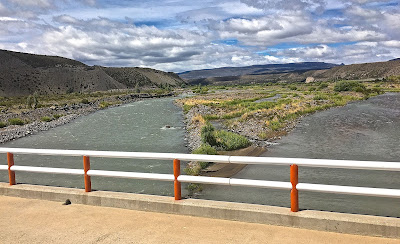Many years ago,
when I was a geography grad student at Berkeley, my mentor Bernard Nietschmann stressed the significance of participant
observation fieldwork in the anthropological tradition of Franz Boas,
Margaret Mead and others. I followed his advice, if not quite with his activist
immersion, in my own academic work on environmental
conservation in northernmost Chile and cultural-historical
geography of the Falkland Islands. Since leaving academic life for travel
and guidebook writing, I’ve done that to some degree, but a few days ago I had a
sardonically amusing experience in that vein.
 |
| Chile Chico, as seen from the panoramic overlook of Plaza del Viento |
Throughout most
of my travels in the Southern
Cone countries, I’ve had the advantage of owning an automobile, which has
often freed me from air and bus timetables. Last week, though, I found myself
in the Patagonian border town of Chile Chico with the need
to cross into Argentina for
the day without using my car. Unfortunately, the usual minibus shuttles to the
town of Los Antiguos
have stopped running because of a punitive Argentine tax that makes the route
economically unviable, so I needed an alternative means of getting there.
 |
| The bus station at Los Antiguos is where many travelers on Ruta 40 start or end their adventure in Argentine Patagonia. |
The border
crossing here is an important one for backpackers, as Los Antiguos is the endpoint
for buses from the more southerly Argentine Patagonia destinations of El Calafate and El Chaltén (and,
conversely, the starting point for southbound travelers on Argentina’s Ruta
Nacional 40). With no shuttles, though, travelers without their own
vehicles are having to walk roughly four miles (6.5 kilometers) between the Argentine
and Chilean border posts, and this is where my “participant observation” comes
in.
 |
| The Río Jeinimeni separates Argentina (left) from Chile (right) |
It’s another six
kilometers or so from Chile Chico proper to Chilean customs and immigration—probably
less than a mile from the Argentine post as the crow flies, but for the waters
of the Río
Jeinemeni—so I decided to drive and leave my car there. En route, I saw several
backpackers walking toward the border post even though local taxis can take up
to three passengers there for about US$10. After parking, carrying only a
daypack, I left Chile and started
walking south toward the bridge across the river.
 |
| As I left Chile, a line of Argentine vehicles waited to cross the border for shopping |
Fortunately, it
was a mild day with relatively gentle winds and, as I left the border complex,
there was a lineup of vehicles waiting to enter Chile (cross-border shopping is
a popular activity for Argentines even when there’s no holiday). En route, I
met at least ten backpackers, including a 71-year-old Israeli, who were trudging
in the opposite direction. After an hour and a half, I reached the Argentine
border post and then took care of business in Los Antiguos, updating some key
information and paying for a pasta lunch with a packet of Argentine pesos still
in my wallet.
 |
| The Argentine border post at Los Antiguos |
Then I started walking
back and, shortly thereafter, I noticed that a series of markers indicated
that, for Argentines, a parallel trail to the actual border was part of a “Stations
of the Cross” memorial and that I had just passed “Jesus falls down.” My cross
wasn’t that hard to bear—I’m not a believer, anyway—but, about a mile from the
Chilean border post, an Argentine family in a pickup truck stopped to offer me
a lift. Having already walked at least 10 miles, I decided to accept and spoke
briefly with them about their shopping trip to Chile Chico—another form of participant
observation, I guess, though it made my own story a bit less epic.
 |
| Only toward the end of my walk did I realize that, for the faithful, it was part of a "Stations of the Cross" route |
Later, in
Chile Chico, I visited a bicycle rental and tour company and learned that
they allow clients to ride into Argentina. As a daily recreational cyclist at
home in California, I’ve missed that while I’ve been in Chile, and I had to reflect
on a missed opportunity.
 |
| Had I realized that I could have taken a rental bike across the border, I would have done so |














